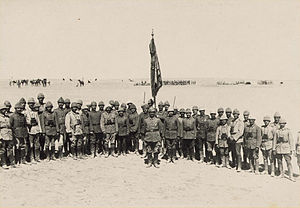
Back معركة غزة الأولى Arabic Birinci Qəzzə döyüşü Azerbaijani بیرینجی غزه دؤیوشو AZB Першая бітва за Газу Byelorussian Першая бітва за Газу BE-X-OLD Първа битка за Газа Bulgarian Første slag om Gaza Danish Erste Schlacht um Gaza German Primera batalla de Gaza Spanish Première bataille de Gaza French
| First Battle of Gaza | |||||||
|---|---|---|---|---|---|---|---|
| Part of the Middle Eastern theatre of World War I | |||||||
 Ottoman officers who successfully defended Gaza during the first battle | |||||||
| |||||||
| Belligerents | |||||||
|
| |||||||
| Commanders and leaders | |||||||
|
|
| ||||||
| Units involved | |||||||
|
| ||||||
| Strength | |||||||
| 31,000 | 19,000 | ||||||
| Casualties and losses | |||||||
|
523 killed 2,932 wounded 512 missing |
| ||||||
The First Battle of Gaza was fought on 26 March 1917 during the first attempt by the Egyptian Expeditionary Force (EEF), which was a British Empire military formation, formed on 10 March 1916 under the command of General Archibald Murray from the Mediterranean Expeditionary Force and the Force in Egypt (1914–15), at the beginning of the Sinai and Palestine Campaign of the First World War. Fighting took place in and around the town of Gaza on the Mediterranean coast when infantry and mounted infantry from the Desert Column, a component of the Eastern Force, attacked the town. Late in the afternoon, on the verge of capturing Gaza, the Desert Column was withdrawn due to concerns about the approaching darkness and large Ottoman reinforcements. This British defeat was followed a few weeks later by the even more emphatic defeat of the Eastern Force at the Second Battle of Gaza in April 1917.
In August 1916, the EEF victory at Romani ended the possibility of land-based attacks on the Suez Canal, first threatened in February 1915 by the Ottoman Raid on the Suez Canal. In December 1916, the newly created Desert Column's victory at the Battle of Magdhaba secured the Mediterranean port of El Arish and the supply route, water pipeline and railway stretching eastwards across the Sinai Peninsula. In January 1917, the victory of the Desert Column at the Battle of Rafa completed the capture of the Sinai Peninsula and brought the EEF within striking distance of Gaza.
Two months later, in March 1917, Gaza was attacked by Eastern Force infantry from the 52nd (Lowland) Division reinforced by an infantry brigade. This attack was protected from the threat of Ottoman reinforcements by the Anzac Mounted Division and a screen from the Imperial Mounted Division. The infantry attack from the south and southeast on the Ottoman garrison in and around Gaza was strongly resisted. While the Imperial Mounted Division continued to hold off threatening Ottoman reinforcements, the Anzac Mounted Division attacked Gaza from the north. They succeeded in entering the town from the north, while a joint infantry and mounted infantry attack on Ali Muntar captured the position. However, the lateness of the hour, the determination of the Ottoman defenders, and the threat from the large Ottoman reinforcements approaching from the north and north east resulted in the decision by the Eastern Force to retreat. It has been suggested that this move snatched defeat from the jaws of victory.
© MMXXIII Rich X Search. We shall prevail. All rights reserved. Rich X Search